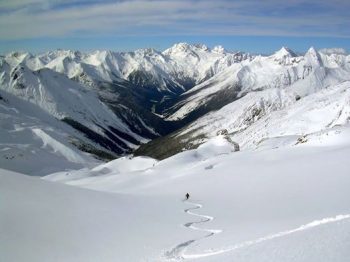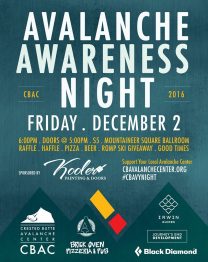Human Factors and Decision Making
By Zach Guy, CBAC Director
This year’s theme to CBAC’s Avalanche Awareness Night on December 2nd, 2016 is “Human Factors and Decision Making”. Almost all avalanche accidents are triggered by the victim or a member of their group. We are the ones who expose ourselves to avalanche risks, and often it is our own decision making that puts us into trouble.
Although humans have been pondering our methods of thinking and rationalizing for centuries, Ian McCammon has been instrumental in research in the avalanche industry. I was fortunate enough to have Ian as a course instructor and mentor for my AVPRO class about 7 years ago, and caught up with him to ask a few questions about human factors and decision making.
 |
| Ian McCammon. Photo courtesy of POWDER magazine. |
Zach Guy: Ian, you have a PhD in mechanical engineering, and a Master’s in Material Science. In the avalanche world, you are well known for your research on human decision making. What inspired your shift in focus from physics towards psychology?
Ian McCammon: My own journey started years ago when a friend of mine died in an avalanche. Using tools from my engineering background, I searched for statistical trends in hundreds of past accidents and found that the circumstances of my friend’s death followed a pattern that repeated itself again and again: risk perception for certain groups was distorted under certain conditions.
Zach: In 2002, you published a paper on heuristic traps and how these human factors affect our decision making and influence avalanche accidents. The acronym “FACETS” (Familiarity, Acceptance, Consistency, Experts, Tracks/Scarcity, and Social Facilitation) has been adopted by essentially every avalanche course around the country to introduce these human factors. My talk at Avalanche Awareness Night will dive into some of these factors and a close call that I had back in 2009. In your research or simply from personal experience since then, are there any other human factors that you think backcountry travelers should be aware of?
Ian: Fatigue is an important physiologic factor that influences our decision making. When you are tired, dehydrated, hungry, cold or just sucking air from a long ascent, it’s hard to judge hazards objectively. And just like the FACETS cognitive traps, fatigue is dangerous because people consistently underestimate how profoundly it can impair their judgement.
Zach: You developed some systematic tools to help backcountry travelers overcome our human biases, such as ALPTRUTH and Lemons. Do you have any other personal tips or strategies that you use in your ski tours for overcoming the inherent biases in the way our brains process information and make decisions?
Ian: ALPTRUTh was designed to do two things. First, it stops you at the cusp of a decision – it breaks the momentum that sometimes carries people into trouble. Second, it helps you see how your group’s decision will be viewed should an accident take place – a process called a pre-mortem. There are other ways to do this, and my hope is that new and better tools will emerge from research into this important area.
Another strategy in addition to APLTRUTh is to choose your partners wisely. Choose people with the wisdom to stop the group’s momentum at the right times and reconsider evidence and the opinions of the group. If they can do that, it’s going to be less frustrating and more effective to manage risk as a group.
Zach: Social media has exploded since your original research 15 years ago. We have a presenter who will be touching on this subject at Avalanche Awareness Night. With Facebook, Instagram, Youtube, etc., the entire internet is watching what we do in the backcountry. What is your take on the impact of social media on our decision making, and do you suggest or have any strategies for handling its potential influences?
Ian: This is a fascinating and worthy topic for research. I am glad you have a presenter exploring this subject. Some folks are choosing to literally create their social identities in near-real time as their decisions and outcomes are posted and amplified across an audience of friends and potential critics. An important question for each of us is how much are we willing to allow that unseen audience to shape our critical decisions.
Zach: Any parting words for our Colorado audience that recreates in the deadliest snowpack in the country?
Ian: To paraphrase Baltasar Gracian: Know your major weakness. If you do not understand it, it will rule you like a tyrant.
Zach: Thank you Ian for sharing your wisdom, and for your contributions to the avalanche industry.
Join us at CBAC’s Avalanche Awareness Night for more great presentations on human factors and decision making.






